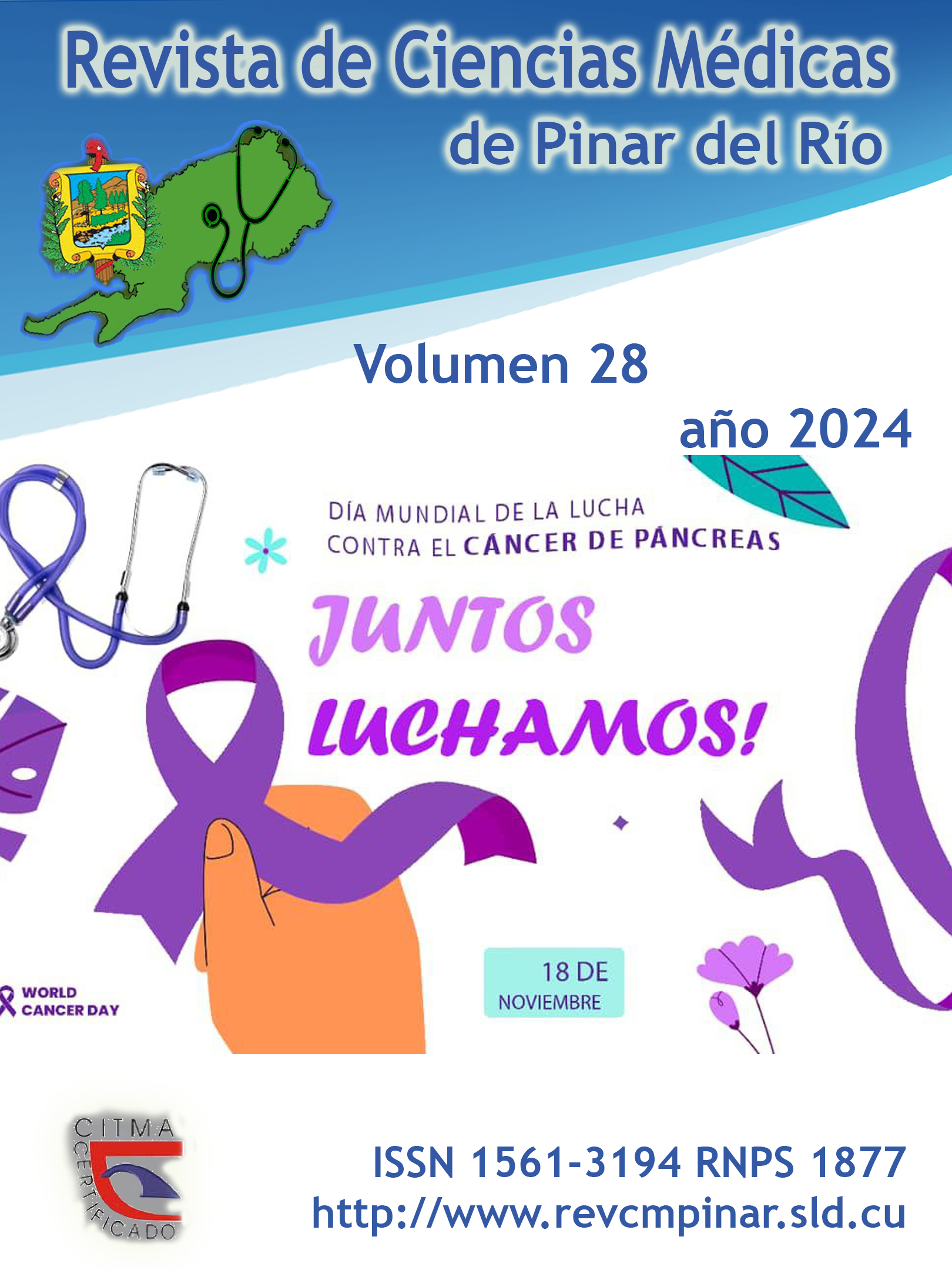Students' characterization with visual disabilities served by the “José Martí” Special School of Pinar del Río
Keywords:
VISUAL DISABILITY, VISUAL ACUITY, OPHTHALMOLOGICAL DIAGNOSIS, BLIND, LOW VISION.Abstract
Introduction: the vision, the man's most reliable sense, plays an essential role in all spheres of life. It is a fundamental part of face- to- face social communication.
Objective: to characterize the students with visual disabilities served by the "Jose Marti" Special School in Pinar del Rio province as Resource and Support Center, in the period from September 2022 to May 2023.
Methods: observational, descriptive, cross - sectional study. The universe and the sample were formed of 37 students, coincident from a non-probabilistic intentional sampling and according to the exclusion and inclusion criteria. The medical records were reviewed taking into account the corresponding ethical considerations, and with the consent of the Center's management. Descriptive and inferential statistics were used to tabulate data.
Results: in the sample, the ages between 10 to12 years predominated, the male sex 51,35 %, schooling at the primary level (32,43 %). Out of them, seven students were blind for 18,91 %, and 30 were of low vision for 81,08 %, while 54,05 classified as having slight low vision. Composite hyperopic astigmatism was the most common primary ametropia. The most commonly used optical aids were hypercorrections and manual magnifying glasses. The most used non-optical aids: lighting, lecterns, strong contrasts (black and white), and close -ups.
Conclusions: it is gratifying to achieve that the students with visual disabilities moved with their peer group at the educational level that corresponds to them, with the resources and support necessary for their development taking into account their uniqueness.
Downloads
References
1. Informe Mundial sobre la visión 2021 [Internet]. Agencia Internacional para la Prevención de la Ceguera (IAPB); 2021 [citado 28/10/23]. Disponible en: https://www.iapb.org/es/learn/resources/the-world-report-on-vision/
2. Sixto Fuentes S, Márquez Marrero JL, Sánchez Pando Y, Sánchez Núñez R. Preservar la visión como modo de actuación profesional en Oftalmología. Rev Ciencias Médicas [Internet]. 2021 [citado: 26/10/23]; 25(1): e4683. Disponible en: http://revcmpinar.sld.cu/index.php/publicaciones/article/view/4683
3. Jaramillo-Cerezo A, Torres-Yepes V, Franco-Sánchez I, Llano-Naranjo Y, Arias-Uribe J, Suárez-Escudero JC. Etiología y consideraciones en salud de la discapacidad visual en la primera infancia: RevMexOftalmol [Internet]. 2022 [citado: 26/10/23]; 96(1): 27-36. Disponible en: https://www.scielo.org.mx/scielo.php?script=sci_arttext&pid=S2604-12272022000100027
4. Núñez Castillo CY, Quinzan King A, Cueto Marín RN, Valle Castañeda W. Efectos psicosociales de la cirugía intraocular en una unidad oftalmológica. Rev Ciencias Médicas [Internet]. 2019 [citado: 24/10/23]; 23(6): 947-953. Disponible en: http://revcmpinar.sld.cu/index.php/publicaciones/article/view/4061
5. López Fernández W, Díaz Reyes A. Discapacidad visual: rehabilitación e inclusión social. IV Convención Internacional de Salud, Cuba Salud. 17 -21 Octubre 2022[Internet]. La Habana: Cuba; 2022 [citado 24/10/23]. Disponible en: https://convencionsalud.sld.cu/index.php/convencionsalud22/2022/paper/download/1117/1610.
6. Serpa Valdes M, González Cabrera Y, Chaswell Quiroga Y, Leal Hernández B, Rodríguez Mazo S. La ceguera y la baja visión en Cuba y en el mundo.Revista Cubana de Oftalmología [Internet]. 2023[citado: 28/10/23]; 36(1): e1659 Disponible en: https://revoftalmologia.sld.cu/index.php/oftalmologia/article/view/1659
7. OzenTunay Z, Ustunyurt Z, Idil A. Causes of severe visual impairment in infants and methods of management. Eye (Lond) [Internet]. 2021 Apr [citado 28/10/23]; 35(4): 1191-1197. Disponible en: https://www.ncbi.nlm.nih.gov/pmc/articles/PMC8115480/.
8. Roselló Leyva A, Hernández Baguer R, González Cabrera Y, Leal Hernadez B, Roig Catillo R. Caracterización de la baja visión en el Centro de Recursos y Apoyo “Abel Santamaría Cuadrado”. Revista Cubana de Oftalmología [Internet]. 2022(Abr-Jun) [citado: 28/10/23]; 35(2): e1144. Disponible en: https://revoftalmologia.sld.cu/index.php/oftalmologia/article/view/1144
9. Yero Lorente O, Rodríguez Valdés M, Abreu Jáuregui Y, Abreu Velázquez M, Pérez Acosta L, Figueredo Ocampo Y. Comportamiento de las afecciones oculares infantiles en la provincia de Cienfuegos. 2019. Medisur [Internet]. 2020 [citado 28/10/23]; 18(4): 631-638. Disponible en: http://www.medisur.sld.cu/index.php/medisur/article/view/4599
10. León Vázquez T, Piñón González JC, Álvarez Pérez J. Problemas visuales en niños de edad escolar Visual. Educación Médica Superior [Internet]. 2023 [citado: 28/10/23]; 37(3): e3888. Disponible en: https://ems.sld.cu/index.php/ems/article/view/3888
11. Casanueva Cabeza HC, González Blanco Y, Méndez Sánchez TJ, Porta Díaz Y, Abdo Cuza AA. Miopía en pacientes con retinopatía de la prematuridad. Revista Cubana de Oftalmología [Internet]. 2022 [citado 28/10/23]; 35(1):e1526. Disponible en: https://revoftalmologia.sld.cu/index.php/oftalmologia/article/view/1526
12. Del Álamo Martín MT, González Polo J. Promoción de la autonomía personal y discapacidad visual. [Internet]. 2020 [citado28/10/23]; 17(2): 214-224. Disponible en: https://www.revistatog.es/ojs/index.php/tog/article/view/91
13. Casanueva Cabeza HC, Pérez de la Rosa M, Porta Díaz Y, Méndez Sánchez TJ, González Blanco Y. Defectos refractivos en pacientes prematuros. Revista Cubana de Oftalmología [Internet]. 2021 [citado: 8/11/23]; 34(4): e1142. Disponible en: https://revoftalmologia.sld.cu/index.php/oftalmologia/article/view/1142
14. Herrera Juárez G, Valenzuela Mancilla LE, Leal Arellano MA, Socorro Sánchez Sánchez A. Ayudas ópticas y no ópticas en la baja visión. Revista Cubana de Oftalmología [Internet]. 2018 [citado: 25/10/23]; 31(3): 1-7. Disponible en: http://scielo.sld.cu/scielo.php?script=sci_arttext&pid=S0864-21762018000300011
15. Díaz Morales CC. La inclusión del estudiantado ciego en la escuela regular en Cuba. Revista EmerginTrends in Education [Internet]. 2019 [citado: 28/10/23]; 1(2). Disponible en: https://www.researchgate.net/publication/333902540_La_inclusion_del_estudiantado_ciego_en_la_escuela_regular_en_Cuba
Downloads
Published
How to Cite
Issue
Section
License
Authors who have publications with this journal agree to the following terms: Authors will retain their copyrights and grant the journal the right of first publication of their work, which will be publication of their work, which will be simultaneously subject to the Creative Commons Attribution License (CC-BY-NC 4.0) that allows third parties to share the work as long as its author and first publication in this journal are indicated.
Authors may adopt other non-exclusive license agreements for distribution of the published version of the work (e.g.: deposit it in an institutional telematic archive or publish it in a volume). Likewise, and according to the recommendations of the Medical Sciences Editorial (ECIMED), authors must declare in each article their contribution according to the CRediT taxonomy (contributor roles). This taxonomy includes 14 roles, which can be used to represent the tasks typically performed by contributors in scientific academic production. It should be consulted in monograph) whenever initial publication in this journal is indicated. Authors are allowed and encouraged to disseminate their work through the Internet (e.g., in institutional telematic archives or on their web page) before and during the submission process, which may produce interesting exchanges and increase citations of the published work. (See The effect of open access). https://casrai.org/credit/



